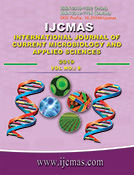


 National Academy of Agricultural Sciences (NAAS)
National Academy of Agricultural Sciences (NAAS)

|
PRINT ISSN : 2319-7692
Online ISSN : 2319-7706 Issues : 12 per year Publisher : Excellent Publishers Email : editorijcmas@gmail.com / submit@ijcmas.com Editor-in-chief: Dr.M.Prakash Index Copernicus ICV 2018: 95.39 NAAS RATING 2020: 5.38 |
We succeeded in large volume artificial cultivation of Onygena corvina. The appearance (shape, color, and size) of fruiting bodies of cultured bacteria was almost the same as that of wild one. We screened their metabolites for antiproliferative activities against nine human cancer cells in vitro. Culture filtrates (metabolite-containing media) of O. corvina were lyophilized and resuspended in phosphate buffer to investigate them in vitro. As a result, these metabolites effectively inhibited the growth of some cancer cells in a concentration-dependent manner. In particular, the effect on lung carcinoma Hara cells was remarkable, but there was almost no effect on hepatoma HepG2 cells. In addition, almost no effect was exerted on three normal cells [human hepatocyte (NHH), human mammary epithelial cells (NHME), and human epidermal melanocytes (NHEM)] at the same concentration. Therefore, it was revealed that the human cell proliferation inhibitory effect of the O. corvina metabolites greatly differs in susceptibility depending on the type of cancer cell under the concentration range not affecting normal cells. In vivo experiments demonstrated that the oral administration of the O. corvina metabolites (OC-FD) decreased the tumor growth compared with untreated mice. The OCT extract obtained by extracting ethanol had the same anti-tumor activity as the OC-FD, but this activity was weaker than with OC-FD. On the other hand, when the same experiment was performed on OCT with 2.O.C.11 and 1.O.C.5, respectively, for the EtOAc soluble fraction and water layer, this demonstrated stronger inhibitory activity than when only the OC-FD or OCT was administered. These results revealed these active components may be both low-molecular weight with low polarity (EtOAc soluble) and high-molecular weight, such as a polysaccharide or protein (water soluble). These findings suggest that the unknown compounds in the metabolite-containing media from cultures of O. corvina are potential lead compounds for developing anticancer drugs with extremely mild side effects.
 |
 |
 |
 |
 |